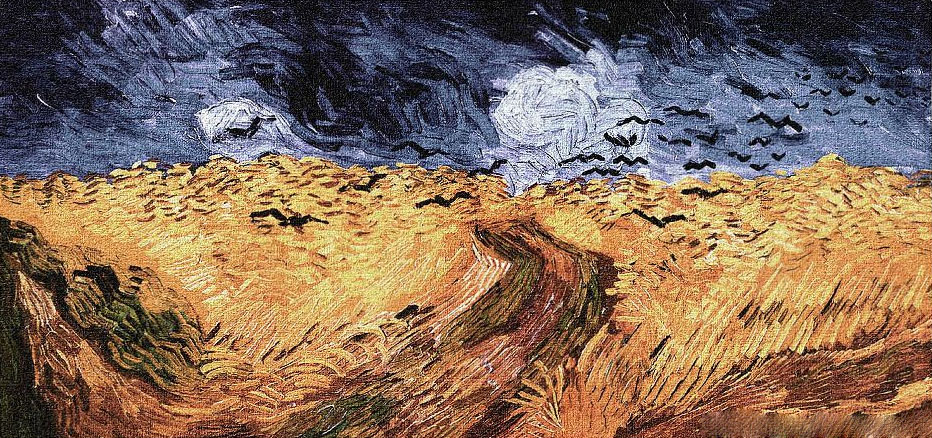… and five characteristics of art student who develop one.
Each fall, young artists submit their artwork to Scholastic Art and Writing Competition hoping that this year judges will see something magic in their art, bestowing the coveted Regional Gold Key and … dare to dream … an even more prestigious National Medal. Right at the top of their “How to Enter” page the Alliance for Young Artists & Writers states clearly the qualities present in a winning submission:
- Originality
- Technical skill
- The emergence of a personal vision
The first two are concrete enough. Originality is an idea that you have not copied from someone else. Technical skill is easy to get: Show them that you can rock those colored pencils. But what exactly is a personal vision, and how does one develop a personal vision for one’s own artwork?
Defining Personal Vision
It is easiest to recognize a personal vision by searching for it in the work of someone well known. Vincent Van Gogh, one of the most famous artists in the world is known for his turbulent, rhythmic paint strokes, driven by the artist’s troubled emotions. His rich paint palette of blues and golds, with paint laid on the canvas as thick as butter on toast are all uniquely his approach to painting. We will recognize his style if we see it in an unfamiliar work stating “Oh, that looks like another Van Gogh. In essence, we have recognized the artist’s personal vision.

The Persistence of Memory by Salvador Dali
Many artists never arrive at a personal vision in a life time, painting landscapes that look essentially like those of hundreds of other artists painting similar landscapes. Some arrive later in life.
Among high school students, it is uncommon to witness a strongly developed personal style, but a select group of dedicated young artists who are persistent and prolific creators will see their personal vision begin to emerge. The Scholastic judges are looking for the exciting beginnings of this quality.
The next question becomes: Can aspiring young artists work toward personal visions of their own? At Cherry Court studios, it is an exciting moment when a student no longer blindly following the lesson at hand, but rather generates an approach to the lesson that is uniquely theirs. In almost all cases, these young artists share backgrounds in common, which have steered them to their own creative moments of truth. Those commonalities are listed below.
Artists most likely to realize a personal vision share this background:
- The student has had a passion for art from an early age. As children, these young artists grabbed any materials available to make images appear on paper and forms appear in space. Pencils, pens, clay, Legos, dirt, scraps, trash etc. were all potential raw materials for expression.
- The student continues to prolifically create art for their own enjoyment. As adolescents, these students are still creating for the sheer enjoyment of the process. From formal sketchbooks to doodles in the margins of math tests, these artists can’t stop creating.
- The student is fascinated by the work of other artists. These are the “influences” that have contributed to the rich styles of all prominent artists we appreciate today. The emerging young artist might internalize advertising art, animations, art from ancient cultures, contemporary art, or traditional art. Any combination will be reinvented into a fresh new visual form.
- The student has someone to cheer them on. The importance of this human need cannot be stressed enough. Art is a form of communication. If no one is nearby to behold, smile and acknowledge, a child will stop creating. Early on, families are the number one supporters of young artists.
- The student has formally studied art. Just as a ballerina has studied dance, and a violinist has studied music, an emerging artist will have studied design, drawing, painting, and art history. Veteran art educators will cite many examples where naturally gifted adolescents, unmotivated or untrained, are quickly surpassed by less talented students who labor hard to develop their skills.
How to achieve a personal vision of your own
For students: If you are a young artist with a burning passion to create, seeking your own personal vision, congratulations. What a wonderful goal. Continue to create the type of art that brings you joy and share your work with family, friends and teachers. If you are not currently enrolled in formal art classes, do so. This includes classes offered in your school as well as classes offered in extracurricular programs. Work on these lessons on your own time to advance faster. Remember that success takes time and hard work.
For parents: If your child has a passion for art, be supportive, provide art materials, and take family trips to local museums, galleries and festivals. Arrange for lessons as early as possible.
There is no time like the present to begin your art studies. Each fall, without fail, I receive at least one phone call from parents who would like to enroll their 12th grade son or daughter at CCS as a new student. They explain that their young artist is talented but has only attended one foundation art class in high school. This is not enough, they continue, to generate the advanced portfolio needed for the top-ranked art school their child would love to attend. The parent ends hopefully, “Can you help John get a portfolio together for the Rhode Island School of Design? It’s due in three months.” Faced with this impossible request, I envision for a second H. G. Well’s time machine transporting the student and his family back to the seventh grade for a second chance at an outstanding education.. Then I deliver the sad news.

